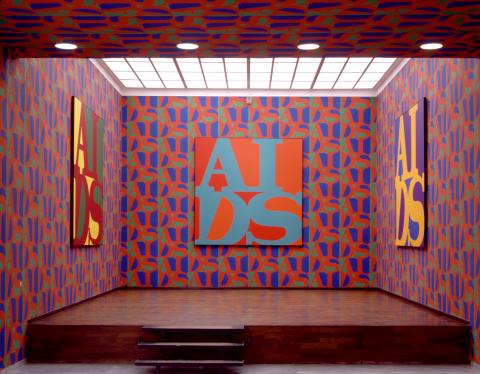
Art Review: “This Will Have Been: Art, Love & Politics in the 1980s”
The exhibition at the Institute of Contemporary Art (ICA), Boston, should disabuse anyone who clings to the notion that art in museums is removed from the real world. “This Will Have Been: Art, Love & Politics of the 1980s” is a visual history of the decade roughly sandwiched between the election of Ronald Reagan and the fall of the Berlin Wall. It showcases almost 100 international artists who were engaged in confronting the issues of their time, including the pervasive influence of the mass media's incessant sales pitches and the HIV/AIDS epidemic.
The paintings, photographs, sculptures and textiles on display through March 3 depict the very different ways that artists interpreted the period. Some, like the graffiti artist Jean-Michel Basquiat, represented by a colorful 1983 mixed media canvas entitled “Hollywood Africans,” invented new images. Others, like artist Sherrie Levine, co-opted images by well-known creators. She repurposed an image by an Austrian artist for her chromogenic development print “Untitled (After Egone Schiele).” In doing so, she raised the question about originality in art. Then she answered it by arguing that art cannot be separated from the history of images.
"This Will Have Been" was organized by the Museum of Contemporary Art, Chicago, and some of the objects from the original show are traveling in other exhibitions, which may explain why the ICA show feels disjointed despite Curator Helen Molesworth’s arrangement of the works according to four themes: Gender Troubles, The End is Near, Democracy, and Desire and Longing.
Gender and racial identity are recurring subjects. In the eighties, individuals defined and redefined themselves. Society looked different through the prism of each change, and the popular culture reflected the ambiguity. Many people didn't understand what was happening.
The Washington Project for the Arts commissioned African-American artist David Hammons to create a portrait honoring the Civil Rights leader, The Rev. Jesse Jackson for a billboard near the National Portrait Gallery. Hammons’ portrait. “How Ya Like Me Now?” shows a hybrid face, pale blond hair and blue eyes on Jackson’s recognizable features. After local African-American youths misunderstood the image as racist and attacked it, the plywood billboard was brought into a gallery. Hammons incorporated the incident into the work by adding a row of upside down sledge hammers along the bottom of the display.
Jeff Koons’ polished stainless steel rabbit icon represents a more benign ambiguity. It resembles an inflatable, even to a crook in the standing rabbit's ear, where the air apparently missed. It looks lightweight and soft. In fact, it is heavy and hard.
Robert Indiana’s 1963 “LOVE” sculpture may be the most emblematic visual of the second half of the 20th century. It’s been reproduced in advertisements, clothing and on numerous consumer products. At the ICA, the famous square sculpture stands beside a wall papered with images of the popular square logo, except the four letter word LOVE has been replaced by the four letter word AIDS. It’s a graphic statement about the transformation of LOVE into AIDS.
The eighties also had a conservative side. Think Margaret Thatcher and President Ronald Reagan. He is represented in the exhibition with a formal portrait by German artist Hans Haacke. The portrait is mounted in a gilt frame as it would be in a traditional museum setting, behind a velvet rope held by two brass stanchions. A red carpet leads from the portrait across the floor to a mural-sized photograph of a crowd protest in New York. Wherever the portrait is exhibited, the mural is changed to a protest in that country.
More than a quarter-century has passed since the beginning of the eighties. Like a class yearbook, "This Will Have Been" is a sentimental looking back, not a summing up.

